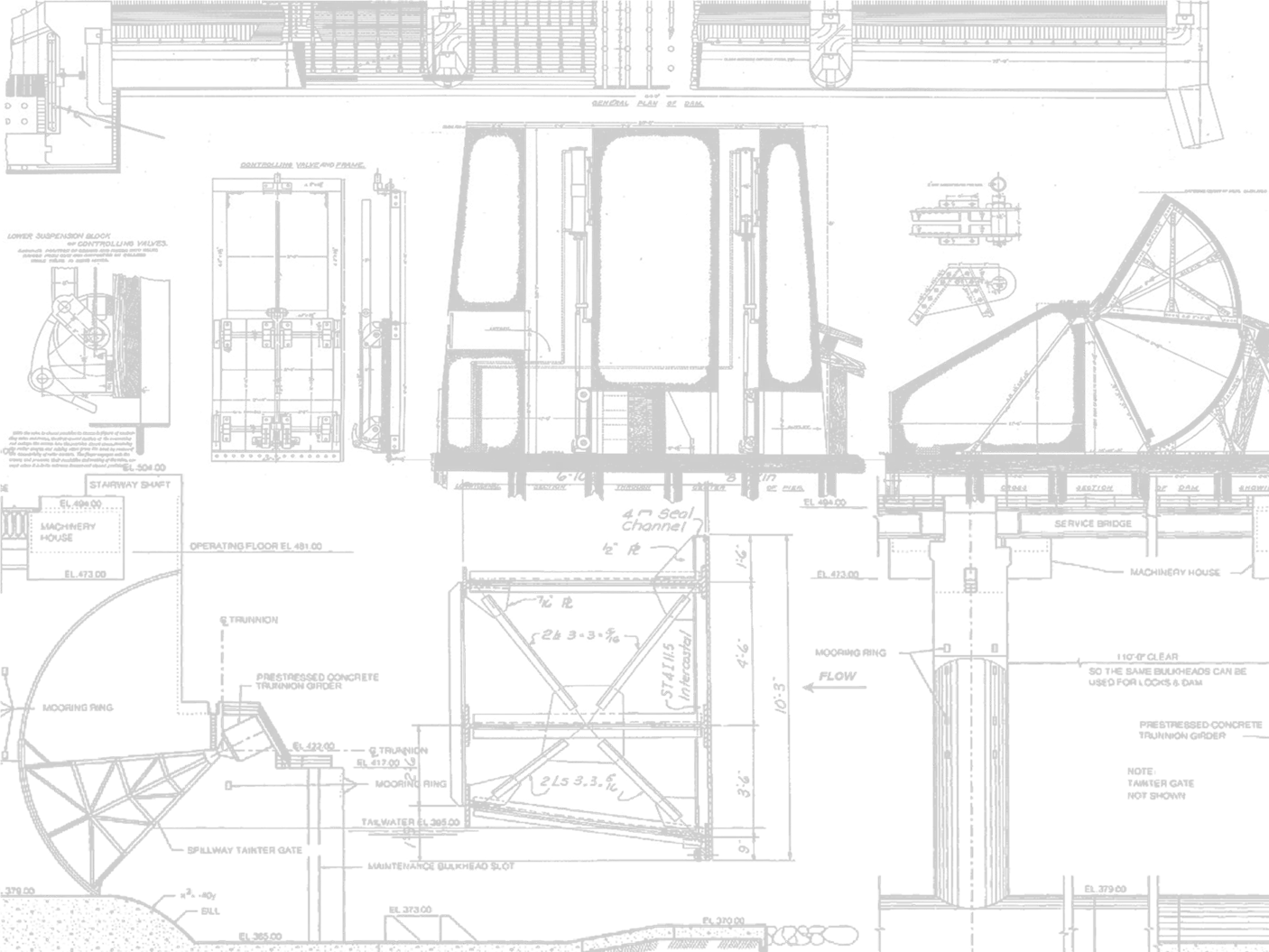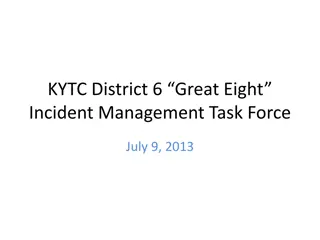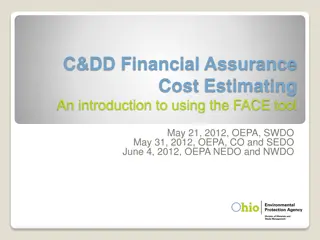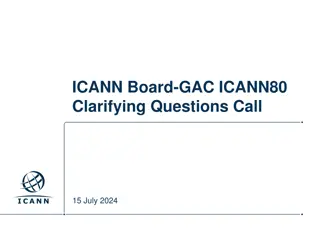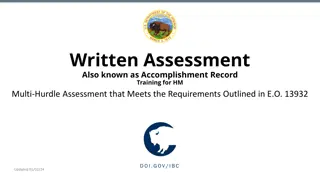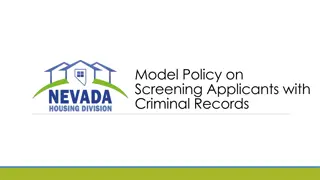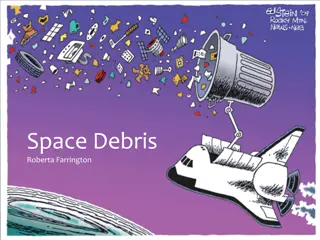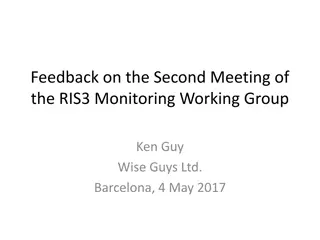Debris Monitoring Operations Presentation for Applicants
Monitoring debris removal operations is crucial for ensuring compliance with guidelines and regulations during debris collection and disposal. This presentation outlines the monitoring requirements, roles of monitors, chain of command, truck management, and quality assurance inspections in debris operations following Hurricane Zeta. It provides valuable insights for Public Assistance applicants involved in debris removal activities.
Download Presentation

Please find below an Image/Link to download the presentation.
The content on the website is provided AS IS for your information and personal use only. It may not be sold, licensed, or shared on other websites without obtaining consent from the author. Download presentation by click this link. If you encounter any issues during the download, it is possible that the publisher has removed the file from their server.
E N D
Presentation Transcript
DEBRIS MONITORING MEMA Presentation for Applicants 237 237 237 217 217 217 200 200 200 80 119 27 252 174 .59 83 36 118 Debris Training Hurricane Zeta DR4576MS (George, Greene, Hancock, Jackson, Perry, Stone and Wayne Counties). 255 255 255 0 0 0 163 163 163 131 132 122 239 65 53 110 135 120 112 92 56 62 102 130 102 56 48 130 120 111 Incident Period: October 28th and 29th, 2020. Declaration Date: December 31st, 2020 1
OVERVIEW Monitoring debris removal operations requires comprehensive observation and documentations by the Public Assistance applicant of debris removal work performed from the point of debris collection to final disposal. Monitoring debris removal work involves constant observation of crews to ensure that workers are performing eligible work in accordance with Public Assistance guidelines, and helps to verify compliance with all applicable Federal State, and local regulations.
MONITORING REQUIREMENTS 44 CFR 13.20(2) Accounting Records Identify Source and Application of Funds Provided for Financially-Assisted Activities 44 CFR 13.40 Monitoring and Reporting Program Performance Requirement to Adequately Monitor Debris Operations
MONITORING DEBRIS OPS (CONT) Roles of your Monitors Your representative Your eyes and ears Make or break a debris operation Every time a monitor signs a load ticket, they are writing a check
DEBRIS MONITORING Chain of Command Truck Management / Placards Debris Loading Quality Assurance Inspection Tower and Site Setup Site Management Safety Reminders
CHAIN OF COMMAND Who has the authority to direct the Contractor s operation? Who will you be reporting to and taking direction from? Know the established working hours to cover the debris mission.
DEBRIS MONITORING Chain of Command Truck Management / Placards Debris Loading Quality Assurance Inspection Tower and Site Setup Site Management Safety Reminders
TRUCK MANAGEMENT / PLACARDS Truck Volume Measurement: Length x width x height / 27 = cubic yard. Subtract the hydraulic box (dog house) from total volume. Document if truck has side boards or not. Measure and note the above information in the truck certification form. Photos work well to establish the condition of the truck / trailer at the time of certification. Trucks and Trailers must have tailgates Installation of Placards on each truck: Placards are installed on each side, written very clearly so field crews and inspectors can read from distances.
DEBRIS MONITORING Chain of Command Truck Management / Placards Debris Loading Quality Assurance Inspection Tower Quality Assurance Site Management Safety Reminders
ELIGIBLE DEBRIS LOADING ISSUES General Criteria Threat to public health & safety Direct result of declared event Within maintained Public Property Public ROW Public maintained property such a government offices, schools, parks etc. Applicant s legal jurisdiction and responsibility at time of disaster
Curbside Pickup 13 9
DEBRIS TYPES Vegetative Construction & Demolition C&D Mixed Hazardous
LOADING TRUCKS Machine Loads Loaders should have height capability to compact load into truck/trailer. Mechanical loaders Include Front-end loaders such as Bobcats and Knuckle-Boom type loaders
WHY NO-HAND LOAD POLICY? Vertical Fluff Loads are the Norm
STUMPS Validation Pre Validation Lists with GPS locations to provide to FEMA monitors. Post Validation Lists, Pictures, Descriptions, etc Eligibility Uprooted 50% or more, and poses an immediate threat to life, public health and safety; on a public ROW, improved public property or improved property of a PNP 24 inches and above, removed on a per stump cost 24 inches and below, removed at a unit cost rate of veg debris. Note: All stumps are to be measured two feet above normal ground level.
STUMPS Uprooted 50% or less, and poses an immediate threat to life, public health and safety; on a public ROW, improved public property or improved property of a PNP Flush cut. Cut portion as a unit cost rate of veg debris Covered under 9523.11 Stump Policy Grinding of stumps meeting other eligibility criteria Typically is not eligible. On rare occasions FEMA may consider requests on a case by case basis and must be the most cost effective method. Must be validated by FEMA monitors.
STUMPS (CONT) FEMA Hazardous Stump Worksheet Applicant: _______________________________________________ Date: ________________________________ Applicant Representative:-__________________________________ Signature: ____________________________________________ FEMA Representative (If Available): __________________________ Signature: ____________________________________________ State Representative (If Available): ___________________________ Signature: ____________________________________________ Physical Location Street Address/Road/Cross Streets Description of Facility (ROW, City Hall, etc.) Fill for Debris Stumps GPS Hazard? Eligible? Comments See Attached Sketch Photo, etc. Tree Size (Diameter) Decimal Degrees (00.000000) Lattitude (N) Longitude (W) Yes No Yes No CY 1 2 3 4 5 6 7 8 9 10
LEANERS Validation/Eligibility Pre Validation Lists with GPS locations to provide to FEMA monitors. Post Validation Lists, Pictures, Descriptions, etc Contracts Unit Cost per Tree Unit Cost as Debris Based on experience in dealing with storms over the past few years cradle to grave contracts including disposal, are less confusing and more efficient.
HANGERS Validation/Eligibility Pre Validation Lists with GPS locations to provide to FEMA monitors. Post Validation Lists, Pictures, Descriptions, etc Eligibility 2 or greater at the break Contracts Unit Cost per hanger or hanger tree Preferred contract by Hanger Tree , with single or split scope Based on experience in dealing with storms over the past few years, cradle to grave contracts including disposal, are less confusing and more efficient.
HANGERS (CONT) Find the hanger! Is it eligible?
HANGERS (CONT) FEMA Hazardous Hangers Worksheet (Contracted per Hanger/Hangers) Applicant: _______________________________________________ Date: ______________________ Applicant Representative:-__________________________________ Signature: ____________________________________ FEMA Representative (If Available): __________________________ Signature: ____________________________________ State Representative (If Available): ___________________________ Signature: ____________________________________ Physical Location Street Address/Road/Cross Streets of Tree GPS Description of Facility (ROW, City Hall, etc.) Hazard? Eligible? Comments See Attached Sketch Photo, etc. Decimal Degrees (00.000000) Number of Hangers Lattitude (N) Longitude (W) Yes No Yes No 1 2 3 4 5 6 7 8 9 10
DEBRIS LOADING Picture of truck being loaded
DEBRIS TICKETS Load Tickets: Need to be simple and legible. Need to indicate the location the debris was picked up. Need to indicate type of debris. Do not issue tickets for ineligible debris. Always protect as if it were your own checkbook as it represents a form of payment verification.
DEBRIS MONITORING Chain of Command Truck Management / Placards Debris Loading Quality Assurance Inspection Tower and Site Setup Site Management Safety Reminders
INSPECTION TOWER AND SITE SETUP Tower location to inspect trucks entering and leaving site. Incineration locations and grinding sites: Check prevailing winds and maintain at least a 200 300 foot buffer zones. Traffic flow and equipment.
31 ESTIMATING LOADS
32 ESTIMATING LOADS
DEBRIS MONITORING Chain of Command Truck Management / Placards Debris Loading Quality Assurance Inspection Tower and Site Setup Site Management Safety Reminders
VOLUME VS WEIGHT CY is a very subjective call at best Even experienced monitors call loads at higher than actual volume Weight is the best method Cost will be more accurate Cleanup will be faster Contractor will pick up EVERYTHING. Still need to monitor closely Easier to monitor FEMA WILL reimburse for the use of portable scales
36 REDUCTION
37 DEBRIS REDUCTION Open Burning Clean, Woody Debris Rural Areas Ash-Soil Additive Air Curtain Pit Incineration Substantial Volume Reduction Reduced environmental Concerns Portable Air Curtain Incinerators Pre-manufactured pit
38 BURNING / INCINERATION
39 CHIPPING AND GRINDING Vegetative Debris Reduction Differences Burning -95% Chipping/Grinding 75% Remaining Volume Should Have Benefit or Use Recycling Wood Chips for Mulch or for Boiler Fuel Supports Environmental Concerns
DEBRIS MONITORING Chain of Command Truck Management / Placards Debris Loading Quality Assurance Inspection Tower and Site Setup Truck Scale Implementation Safety Reminders
SAFETY REMINDERS Become familiar with county, state and federal safety requirements concerning debris removal operations. Require all employees to use the necessary Personal Protective Equipment- PPE. Hard hats, gloves, steel toe boots, chain-saw safety leg chaps, safety vest, hearing and eye protection Be current on immunization shots, medical records etc. Have available personal health care items, sun screen, sun glasses, first aid kits, water, etc. Have emergency phone numbers available for all employees, become familiar with hospital and health care providers locations.
SAFETY REMINDERS Know and understand limits of safe equipment operation hours, for example, safe daylight working hours and always consider weather conditions. Traffic control measures, knowledgeable personal and equipment necessary to execute proper traffic control operations, in accordance with state, county and city laws. Safe equipment operations, obey general safety guidelines, do not work boom equipment within 10 feet of electrical power lines. Make sure safety guards and safety warning decals are installed in accordance with manufacture s recommendations.
43 MISCELLANEOUS - - - - - USACE Teams Marine Debris PPDR Demolition TDMS Clean Up


